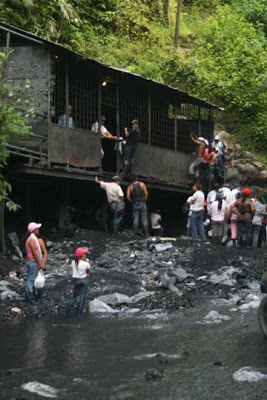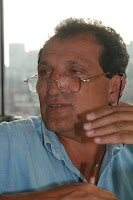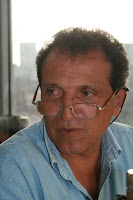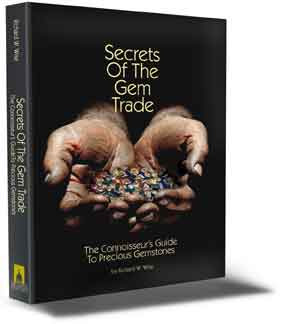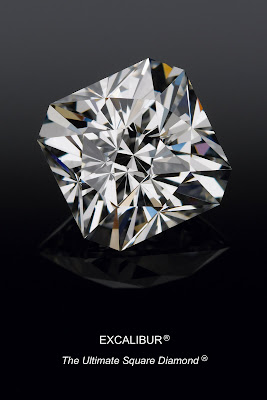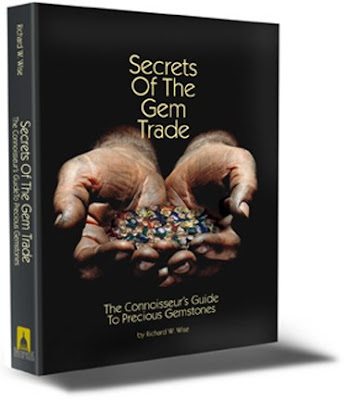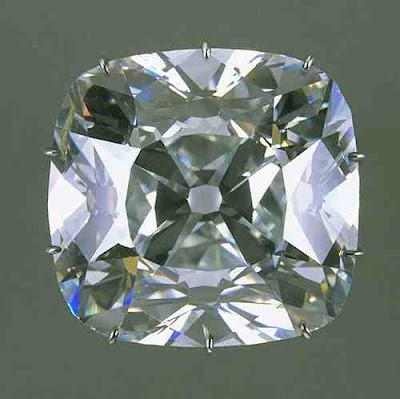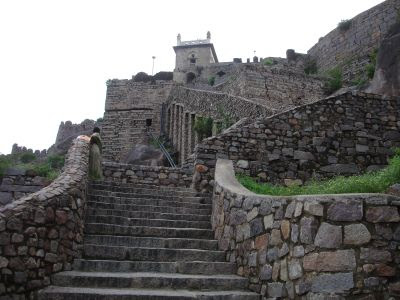By Richard W. Wise, G.G.
The perfectly formed hexagonal crystal showed a verdant medium-dark green color that looked exceptionally fine. I don’t recall the actual weight (somewhere in the 25 carat range) but the crystal was about the size of my index finger. This crystal lacked the jewel-like transparency of the Colombian crystals pictured in Part I and was difficult to evaluate. I could see the pepper like inclusions typical of of Goiás emerald but little else.
like inclusions typical of of Goiás emerald but little else.
The asking price of the Brazilian crystal was a quarter of a million dollars. Long story short, I didn’t make an offer. I thought the crystal lacked the transparency necessary to evaluate it and I wasn’t prepared for a quarter of a million dollar spin of the wheel. I later heard that the crystal had been sold for something close to the asking price and that when it was put on the wheel it had literally exploded leaving the buyer with nothing to show for his purchase.
High Rollers:
Hurry, hurry, hurry and welcome to the high stakes world of the rough buyer where every parcel is a gambol. In this world, where a single bet may exceed a million dollars, the dealer across the table from me is a high roller. The parcel so casually scattered across the desk in front of me is a big time rise. Perhaps 1400 carats, it is from the new mine, La Pita, a complex of adjacent shafts in the Colombian state of Boyaca. One mine actually bears the name La Pita, the others are Consorcio, Cunas, Totumos and Polveros.  In a country where the old mines have been producing since before the Conquistadors conquered their local owners in the mid Sixteenth Century, serious commercial mining only began at La Pita in 1997. (Pictured left: the author works his way through a half mile tunnel to the surface. Foreground, miner pushes cart full of mine tailings, these will be given to guacheros waiting at mine entrance for further sorting: Photo: Ron Ringsrud)
In a country where the old mines have been producing since before the Conquistadors conquered their local owners in the mid Sixteenth Century, serious commercial mining only began at La Pita in 1997. (Pictured left: the author works his way through a half mile tunnel to the surface. Foreground, miner pushes cart full of mine tailings, these will be given to guacheros waiting at mine entrance for further sorting: Photo: Ron Ringsrud)
We are about to watch the fashioning of two of these crystals into gemstones. In this high stakes world a dealer needs an edge. Having a lapidary with the skill of Adolpho Argotty is just such an edge. According to Argotty, in his workshop, loss on the cutting wheel is perhaps 4% and that is perhaps why Argotty is rated the best. He is presently traiing the second generaltion, his niece, Fernanda, who sits at a wheel at his side (see image above right).
Argotty doesn’t just pre-form the stone he supervises the entire process:
“Would you ask an architect to just put up the bones of a structure and let others finish it?” he asks.
(images: above: Adolpho Argotty, holds forth: Picture Richard W. Wise) It takes just about a half an hour. Argotty works away the emerald held between his thumb and forefinger. He grinds a bit then holds the stone up and squints at it in the sunlight all the time carrying on an animated conversation in Spanish with my partner Ron Ringsrud. Ron loves Colombia. He deals exclusively in Colombian Emeralds, has been coming to Bogotá for twenty-five years and speaks fluent Spanish.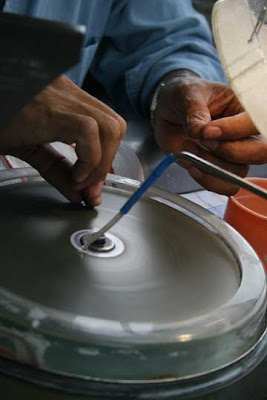
The workshop is surrounded by windows on three sides. The light is good. The two crystals have been blocked out, that is to say, they are now the size and shape of the finished gem. Argotty decided to cut the best crystal into a standard rectangular emerald cut. The stone started out at 7.17 carats it now weighs 4.77 carats and it is ready for the faceting wheel. Argotty is excited about this gem. He hands it to Maria Fernanda to polish the table, he wants a closer look.
She hands it back.
“This one”, he says, “will be worth at least $10,000 per carat.”
The second stone which began at 8.53 carats has been shaped into what Argotty is calling a rose cut. I am confused because the stone obviously has a pavilion and looks very much like an antique style emerald cut with overly large corners.  Later we figure out the problem is in translation, Argotty means an old style cut which this stone obviously is. Even before polishing commences we see visible inclusions in the stone. It now weighs 6.44 carats.
Later we figure out the problem is in translation, Argotty means an old style cut which this stone obviously is. Even before polishing commences we see visible inclusions in the stone. It now weighs 6.44 carats.
Step #1 Sealing & Certification:
In Adolpho Argotty’s workshop, preformed stones are dipped into hot paraffin.  The objective is to seal any surface breaking fissures to insure that no residue of the polishing compound makes its way inside the stone.
The objective is to seal any surface breaking fissures to insure that no residue of the polishing compound makes its way inside the stone.
Colombian cutters become a bit testy when the subject of lab grading is raised. If you love emerald you must be prepared to accept some surface breaking fissures and yes, cedar oil is universally used as a treatment to hide these fissures. However, both dealers and cutters feel that they are getting a bad rap from some American and European Gem Labs. Most labs use a uniform four step grading process to grade the level of enhancement: none, minor, moderate and heavy. Gubelin adds insignificant between none and minor and AGL (American Gemological Laboratories) uses its own proprietary scale. Columbian Esmeraldaros believe that this system lacks consistency. The labs, they contend, are afraid to use the term none. According to Argotty, he has delivered emeralds that he personally cut and knows to be totally without enhancement, to major European labs which in turned issued reports claiming these emerald contained a filler. The reader should bear in mind that a certificate grade of none is in no sense a clarity grade,the stone can still look like a broken coke bottle. It just contains no filler, no clarity enhancement.
I examined hundreds of finer stones in the course of my week in the Bogata market and with but a single exception, every stone I saw had some surface breaking fissures. Taking Ron Ringsrud’s advise I rejected any stone with fissures on the crown or girdle or those with fissures on the pavilion that I felt might n anyway compromised the durability of the stone. This, by the way, would make a good definition of the term minor enhancement.
Next, Dopping, Faceting and Polishing. Stay Tuned.
Learn the truth about how Emeralds and other fine gems are graded and priced!
Follow me on gem buying adventures in the pearl farms of Tahiti. Visit the gem fields of Australia and Brazil. 1
20 carefully selected photographs showing examples of the highest quality gems to educate the eye, including the Rockefeller Sapphire and many more of the world’s most famous gems. Consider my book: Secrets Of The Gem Trade, The Connoisseur’s Guide To Precious Gemstones.
educate the eye, including the Rockefeller Sapphire and many more of the world’s most famous gems. Consider my book: Secrets Of The Gem Trade, The Connoisseur’s Guide To Precious Gemstones.
“Wise is a renowned author… He’s
done a marvelous job of this first book, monumental work, a tour de force…My recommendation: Buy this book”.
Charles Lewton-Brain, Orchid
whether you like to know what the best colour is in Tanzanite, or how to grade a Diamond, you will find it in this book. No other book I read before dealt with this topic is such detail as Richard Wise’s masterpiece.”
A. Van Acker, FGA
Amazon June 2005
“Secrets Of The Gem Trade: The Connoisseurs Guide To Precious Gemstones by Richard W. Wise is an impressive new reference for dedicated dealers and collectors of gems, gemstones, and … pearls. Introducing and descriptively exploring each and every gem covered in the easy-to-use reference, Secrets Of The Gem Trade contains an illustrated summary of each stone inclusive of its history and general information, hue and tone, saturation, which may be noticed as the finest, an understanding of the particular gems rarity, and the caution for synthetics and how to depict them, however depending upon the stone there may be description of clarity, color fading, multi-color effect, etc. Secrets Of The Gem Trade is very highly recommended to anyone interested in gemology as a superbly organized, authoritative, comprehensive, and easy-to-follow reference.”
Midwest Book Review
April 2006
Only $31.95. Read a couple of chapters online: www.secretsofthegemtrade.com.
Buy it on Amazon: www.amazon.com

